FHWA-HEP-19-003
Printer-friendly PDF →
FHWA Eco-Logical Case Studies Series
Example of Implementing Eco-Logical
Year One Snapshot: Maine Department of Transportation Atlantic Salmon Programmatic Consultation
Agency: Maine Department of Transportation (MaineDOT)
Eco-Logical Snapshots check in with transportation agencies around the country that are already utilizing the later stages of the Eco-Logical approach to expedite project delivery and achieve environmental outcomes. These Snapshots focus on cost and time savings achieved through better integration of infrastructure development and conservation planning.
This case study is a follow-up to the Atlantic Salmon Programmatic developed by FHWA and Maine Department of Transportation (MaineDOT) that incorporated concepts from the Eco-Logical approach.
A second follow-up to this case study, the Year Two Snapshot, reviews the second full year of implementation of the Atlantic salmon programmatic consultation, with a focus on the cost and time savings achieved since its enactment in 2017.
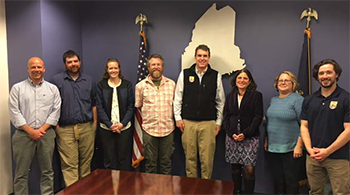
Photo of Atlantic salmon programmatic consultation team (Courtesy of MaineDOT)
The FHWA, Maine Department of Transportation (MaineDOT), the U.S. Fish and Wildlife Service (USFWS), U.S. Army Corps of Engineers (USACE), and the Maine Turnpike Authority developed a programmatic consultation process for the federally-listed endangered Atlantic salmon and its critical habitat.
As part of the development of the programmatic consultation process, these transportation and regulatory partners prioritized Atlantic salmon habitat recovery watersheds, developed monitoring protocols which have allowed for expedited project review and delivery, and initiated the creation of the Atlantic salmon-specific In-Lieu Fee (ILF) program.
This effort took 4 years to complete at an estimated cost of $276,000 (with $250,000 from an FHWA Eco-Logical Implementation Assistance grant).
More details regarding development of the programmatic agreement and consultation process are available in a 2017 Eco-Logical Case Study.
Results of Programmatic Solution
Within its first full year of implementation, MaineDOT and their partners are already seeing results. Since its enactment in 2017, the programmatic consultation process had led to:
- A 229% increase in number of complete consultations helping to alleviate backlog of approximately 40 Biological Assessments (BAs) for salmon-related projects requiring USFWS review.
- Completion of 96% of consultations on schedule compared to 20% pre-programmatic consultation.
- Review timeframes vastly exceed programmatic streamlining goals:
- 78% faster reviews for informal consultations.
- 76% faster reviews for formal consultations.
- $230,000 estimated annually on consultations.
- Restoration of high-value habitat access for Atlantic salmon.
- Increased trust between transportation resource and regulatory agencies, resulting in increased communication and shortened review times.
Data presented in this snapshot is based on information provided by MaineDOT and contained in the Maine Atlantic Salmon Programmatic Agreement Annual Report presented at the 2017 annual meeting required by the programmatic agreement.
Programmatic Consultation in Action
The programmatic consultation was developed to meet the following goals:
- Decrease permitting time
- Reduce costs and duplicative efforts
- Foster resource agency partnerships
- Improve outcomes for Atlantic salmon and critical habitat
- Improve highway asset resiliency and safety
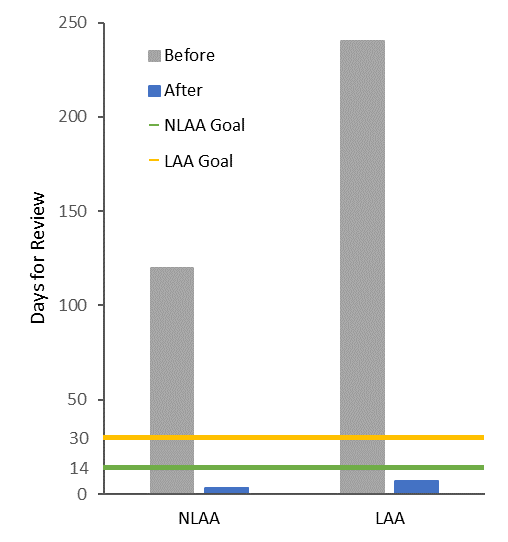
Timeline for project reviews before and after implementation of programmatic (FHWA/Volpe)
Decreased Backlog and Increased Efficiency
Under the programmatic consultation, 23 projects were reviewed in 2017 (compared to only ~7 annually prior to the programmatic consultation). Compared to only 20% pre-programmatic, 96% of these projects surpassed stated review timeframe goals.
- The programmatic goal for informal consultations, Not Likely to Adversely Affect (NLAA) determinations, is 14 days. Reviews for the 20 projects in this category were completed in an average of 3 days.
- The goal for formal consultations, Likely to Adversely Affect (LAA) determinations, is 30 days. The 3 projects in this category were reviewed in an average of 7 days.
This increase in efficiency is largely due to:
- The development of a streamlined 11-page Project Notification Form (PNF) for programmatic criteria review, replacing 50-100 page biological assessments (BAs).
- Early and frequent contact between MaineDOT and federal permitting agencies
Annual Cost Savings
With the programmatic consultation in effect, MaineDOT saved:
- $230,000 (estimated) in 2017 on the consultation process alone, based on approximately $10,000 per project. The entire lifecycle of the permitting process is now more consistent and predictable. This eliminates the need for costly consultations and prevents cost overruns on both materials and contract penalties.
- 80-100 hours of staff time per project for MaineDOT, FHWA and USACE through implementation of the PNF. This shorter form makes it easier to categorize projects and has replaced lengthy letter of concurrence requests and BAs that required a substantial amount of time to complete.
Better Environmental Outcomes
Culvert replacement and other stream crossing repairs allow MaineDOT to contribute to Atlantic salmon recovery. Using habitat connectivity designs (HCDs), an approach required under the programmatic agreement, MaineDOT helps restore flow and passage by installing appropriately sized culverts that incorporate the materials and structure of the existing streambed.
In 2017, MaineDOT completed 2 culvert replacements using HCD standards that were consistent with recovery actions described in the Atlantic Salmon Recovery Plan. These standards include:
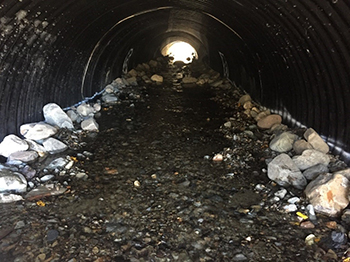
Completed culver replacement at Dyer Brook, ME using stream simulation methods (Courtesy of MaineDOT)
- Improvements at road stream crossings that remove barriers to habitat access.
- Increased habitat connectivity and complexity by mirroring natural stream beds and increasing flow.
- Improving water quality and monitoring to ensure that flow, pH, and turbidity levels, not only meet State and Federal guidelines, but are optimal for all life-stages of Atlantic salmon to thrive.
- Increased resilience of culverts that are essential for maintaining habitat connectivity. Due to their larger size and increased capacity, HCDs better handle high flow events and allow for more natural sediment deposition over traditional designs. This helps prevent clogging and decreases the long-term ecological and financial costs of routine maintenance and repairs following storm events. These benefits help off-set upfront costs associated with their size and materials requirements.
Currently, 80% of culvert replacements that require consultations on Atlantic salmon and Atlantic salmon critical habitat are actively contributing towards recovery.
Improvements in both project design and staffing efficiency are also expected to have wider ranging benefits on other species and critical habitats across the State.
Improving Relationships
Establishing and maintaining inter-agency relationships has been crucial to the success of the Atlantic salmon programmatic consultation. Before the programmatic consultation process these agencies lacked a clear communication strategy, information exchange was slow and consultations were backlogged. This led to increase tensions and disagreement on how to best prioritize projects and value added activities in general.
“MaineDOT, the Maine Division of FHWA, and the Maine Field office of USFWS have forged a unique relationship. The agencies seamlessly work together to process projects that are important to Atlantic salmon and DOT’s production goals.”
- Eric Ham, MaineDOT
Now, discussions between agencies occur frequently both in the office and out in the field and facilitate a process that satisfies the needs of multiple stakeholders. To honor these partnerships and programmatic commitments:
- MaineDOT developed training for engineers in partnership with USFWS and prioritized site visits for LAA projects to ensure that DOT staff and contractors act in accordance with the programmatic agreement.
- USFWS is hosting two full time positions, funded by MaineDOT, dedicated to helping MaineDOT with ESA-related issues. Most of the work revolves around Atlantic salmon.
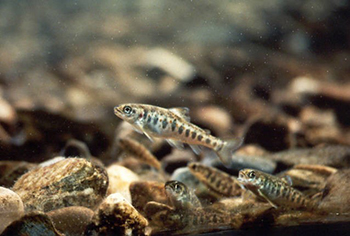
Atlantic salmon juvenile in Maine cobble stream bed (USFWS)
Lessons Learned
Programmatic Approaches Save Time and Money:
MaineDOT has seen increased project efficiency through time and cost savings on individual consultations due to the development of the PNF and established protocols for design, construction and monitoring.
Clear and Consistent Communication Improves Relationships and Results:
All agencies involved report an increase in morale and overall satisfaction throughout the project development and implementation process. This is largely due to more frequent communication, clearly identified expectations and trust that was built throughout the programmatic process.
Reinvest Cost-Savings to Help Offset Short-Term Cost:
MaineDOT can reinvest cost-savings from individual consultations back into project design to facilitate Atlantic salmon environmental considerations. This reinvestment helps offset increased culvert and bridge replacement design costs for HCDs and other improvements required by the programmatic consultation. It not only benefits Atlantic salmon, but will likely benefit MaineDOT in the mid- to long-term through reduced maintenance and repair costs.
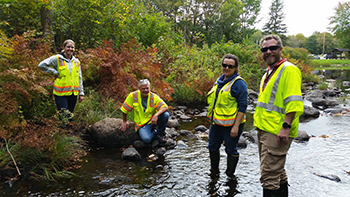
Staff from MaineDOT, FHWA Headquarters, Maine Division Office, and USFWS survey the project in the field (Courtesy of MaineDOT)
Next Steps
Post Construction Monitoring:
MaineDOT will begin post-construction monitoring of finished projects in accordance with the agreement to identify potential issues with water flow, stream substrate composition and stability, and sediment deposition.
In Lieu Fee (ILF) Program:
Over the next year, MaineDOT will work with The Conservation Fund (TCF) and a team from USFWS, NMFS, EPA, and USACE to finalize the ILF program instrument and monitor the implementation of the program.
The ILF operates by allowing applicants for projects requiring federal permits to pay into a general mitigation fund instead of providing project-specific mitigation. Future applicants can apply for funds from the ILF to meet mitigation goals and support larger recovery projects.
Applying Adaptive Management based on Annual Reviews.
Through the annual review process adaptive management will be used to incorporate new information gained from monitoring effects to ensure that all actions maintain the established efficient and conservation goals.
For More Information
Contacts
Eric Ham
Maine Department of Transportation
Environmental Office
(207) 215-7356
Eric.Ham@maine.gov
David Williams
FHWA Office of Project Development and Environmental Review
(202) 366-4074
David.Williams@dot.gov
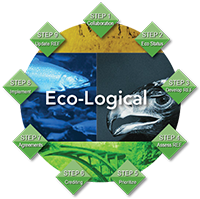
Resources

